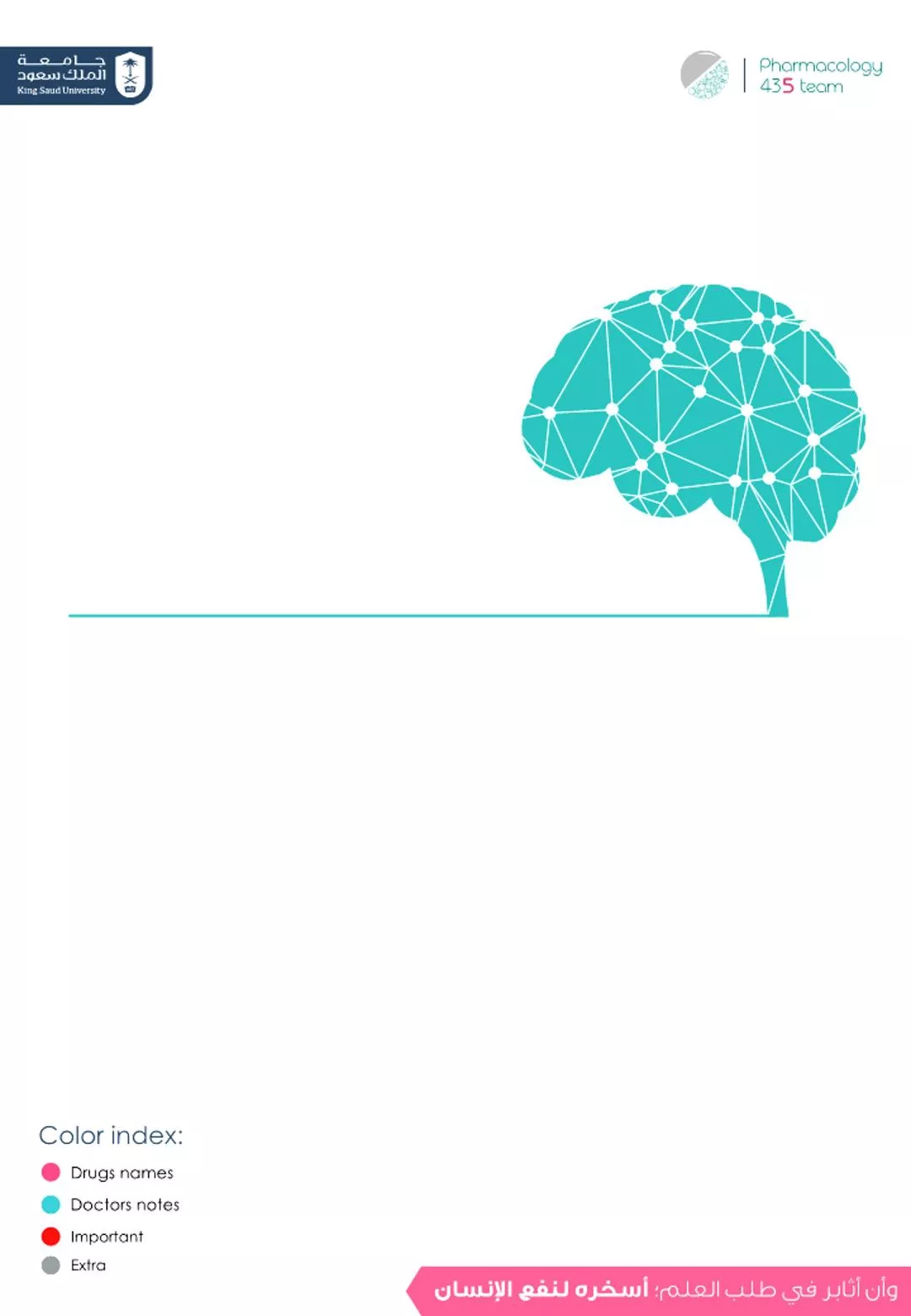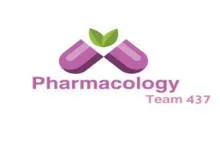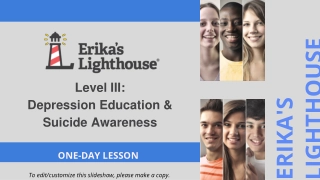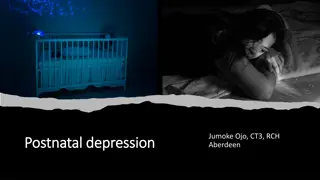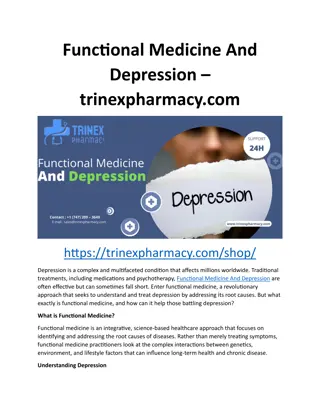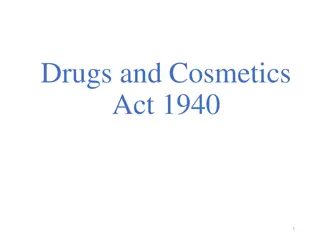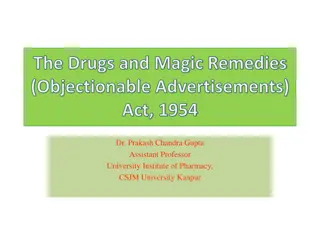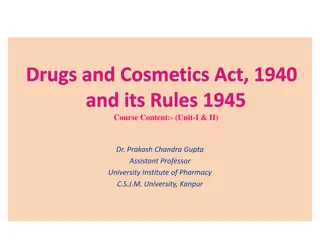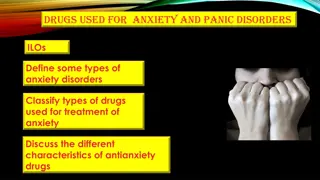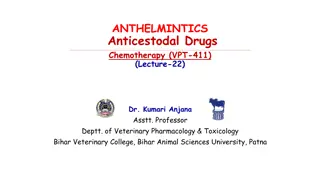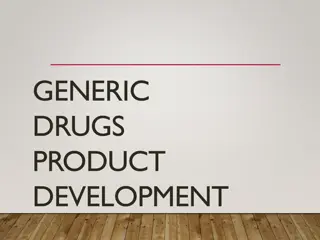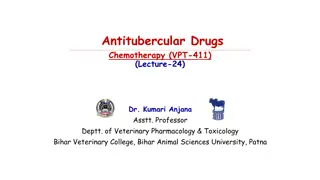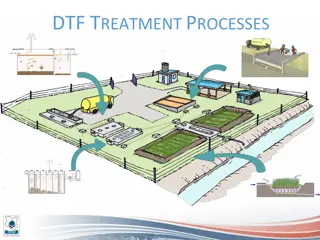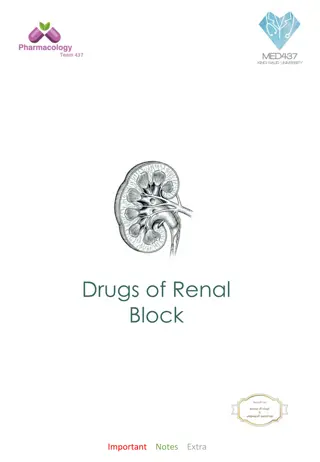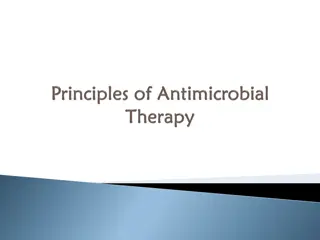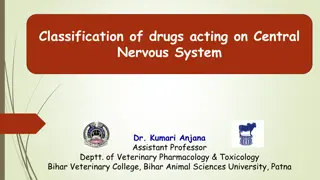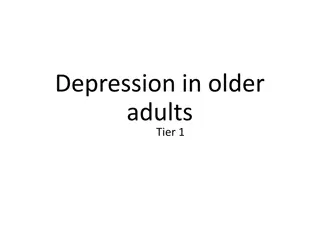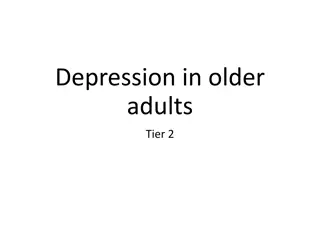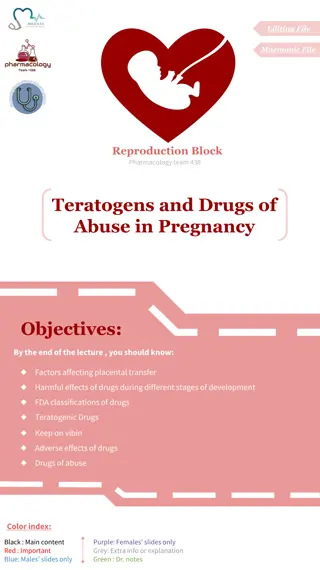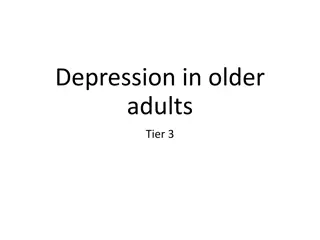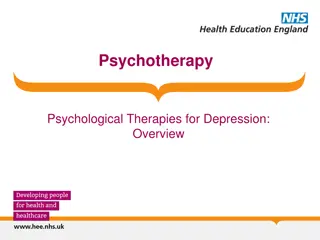Depression and Its Treatment: Old vs. New Drugs
Depression, a common mood disorder affecting millions, is characterized by neurochemical imbalances. Various forms of depression exist, ranging from mild to severe and even psychotic. Symptoms include loss of interest, feelings of worthlessness, and recurrent thoughts of death. Treatment involves increasing neurotransmitter levels like serotonin, dopamine, and norepinephrine. Classic drugs like reserpine deplete neurotransmitters leading to depression, while amphetamines can induce mania. Enhancing understanding of depression helps in developing effective treatment strategies.
Download Presentation

Please find below an Image/Link to download the presentation.
The content on the website is provided AS IS for your information and personal use only. It may not be sold, licensed, or shared on other websites without obtaining consent from the author.If you encounter any issues during the download, it is possible that the publisher has removed the file from their server.
You are allowed to download the files provided on this website for personal or commercial use, subject to the condition that they are used lawfully. All files are the property of their respective owners.
The content on the website is provided AS IS for your information and personal use only. It may not be sold, licensed, or shared on other websites without obtaining consent from the author.
E N D
Presentation Transcript
Depression Definition Depression (major depressive disorder or clinical depression) is a common but serious mood affective disorder. It causes severe symptoms that affect how you feel, think, and handle daily activities, such as sleeping, eating, or working. To be diagnosed with depression, the symptoms must be present for at least two weeks. Pathophysiology - Neurotransmitter Imbalances & Dysregulation creates a state of deficiency in monoamines creates a state of deficiency in NTs (serotonin (5-HT), Dopamine, NE) Changes in mood are associated with depression and/or mania. Disorders of mood rather than disturbance in thought or cognition. Incidence: Depression is a chronic and recurrent illness that can affect at least 20% of the population at some period in their lifetime. An estimated 35-40 million Americans living today will suffer from major Depressive Illness during their lives. Cost: 15-35 billions $ / year in USA only.
Classification of Depression According to severity of symptoms: According to type: Other forms of depression: 1. Mild depression self- limiting 2. Moderate depression difficulties at home and work 3. Severe depression serious, associated with suicidal thoughts 1.Psychotic depression 2.Postpartum depression 3.Atypical depression 2- Bipolar depression (manic-depression): 1- Unipolar depression (major depression): -mood swings are always in the same direction (depression) -About 75% of cases are non-familial accompanied by symptoms of anxiety and agitation Associated with stressful life events -25% familial unrelated to external stresses. endogenous depression -In which depression alternates with mania -It is mainly hereditary and appears in early adult life
Just read it !! Loss of energy and interest Diminished ability to enjoy oneself. Decreased -or increased- sleeping or appetite. Symptoms of Depression Difficulty in concentrating; indecisiveness; slowed or fuzzy thinking. Exaggerated feelings of sadness, hopelessness, or anxiety. Feelings of worthlessness. Recurring thoughts about death and suicide. If most of these symptoms last for two weeks or more, the person probably has Depressive illness causes mood swings creating periods with the following symptoms: Symptoms of A high energy level with decreased need for sleep. Mania Unwarranted or exaggerated belief in one's own ability. Extreme irritability. Rapid, unpredictable emotional changes. Impulsive, thoughtless activity, with a high risk of damaging consequences (i.e., stock speculations, sudden love affairs, etc.).
Biochemical Theory of Affective Disorders Treatment Drugs that NE Affective disorders serotonin NE Mania Drugs that NE NE Depression the neurotransmitters (serotonin, dopamine,NE) are low they cause depression,so we need to increase the level of the neurotransmitters to treat it. - What is the evidence to support this theory ? Amphetamine make you alert it called student drug causes mania while reserpine antihypertensive it deplete NE storage in your body and methyldopa produce antihypertensive decrease NE depression (these drugs depletes NE and dopamine storage). Reserpine: antihypertensive causes depression because it lowers the monoamines in the synaptic cleft. Amphetamine: drugs of addiction, release amounts of monoamines so causes mania and psychosis. may cause the sleep problems (Insomnia), irritability and anxiety associated with depression 5-HT deficiency which regulates mood. alertness, arousal, appetite, reward & drives, may contribute to the fatigue and depressed mood of the illness Decreased level of NE However, dopamine is important for pleasure, sex & psychomotor activity. What are the features of drugs that should be used for treatment of Depression? Simply to increase the levels of these amines
Antidepressants Sites of Action for Antidepressants: MAO metabolism degrdition to serotonin ,NE,Dopamine 1- Monoamine (NE or/and 5-HT) reuptake pump inhibitors 2- Blockade of presynaptic a2receptors 3- Inhibition of MAO enzyme Classification of antidepressants e.g. Most tricyclics (old Antidepressants) Drugs that block the reuptake of NE and 5-HT based on site of action Drugs that selectively block reuptake of 5-HT (SSRIs) (most common) Fluoxetine; Paroxetine; Sertraline; Citalopram (New Antidepressants) e.g.: Drugs that Block Presynaptic 2- adrenoceptors Mirtazapine Mianserin MAOIs, Phenelzine, Tranylcypraine, Moclobemide (old Antidepressants) Drugs that Inhibit MonoAmine Oxidase
Antidepressants available in the market (worldwide) Drugs Class Imipramine, Amoxapine, Maprotiline, Nortriptyline, Trimipramine, Clomipramine, Protriptyline, Desipramine, Amitriptyline Tricyclics (TCAs) and Tetracyclics Monoamine Oxidase Inhibitors (MAOIs) Tranylcypramine not used clinically, Phenelzine use for research not clinically, Moclobemide Selective Serotonin Reuptake Inhibitors (SSRIs) Fluoxetine, Fluvoxamine, Citalopram, Sertraline, Paroxetine, Escitralopram Serotonin and Norepinephrine Reuptake Inhibitor (SNRI) Venlafaxine, Duloxetine Serotonin Antagonist and Reuptake Inhibitors (SARIs) Nefazodone, Trazodone, Norepinephrine and Dopamine Reuptake Inhibitor (NDRI) Bupropion Noradrenaline Reuptake Inhibitor (NRI) Reboxetine Noradrenergic and Specific Serotonergic Antidepressant (NaSSA) Mirtazapine this table contain both old & new antidepressant drugs
Slow onset of action Antidepressants do not act immediately (show clinical effects after 3 weeks) indicating that secondary adaptive changes must occur before the benefit is gained. The most consistent adaptive change seen with antidepressant drugs is the downregulation (Number of receptors decreases) of beta-, alpha-2 and 5-HT2 receptors these receptor up-regulated in depressed patients . Desensitization (down-regulation) of - adrenoceptors (decrease c-AMP) is very important and is related to clinical response that s why antidepressants take 3 weeks to show effect . Old Antidepressant The oldest one Monoamine Oxidase inhibitors Tricyclic antidepressant Tricyclic (They have characteristic three-ring nucleus: - Imipramine - Desipramine - Clomipramine - Amitriptyline Both TCAs & tetracyclic have the same MOA - Nortriptyline - Doxepin - Trimipramine Note: depression also comes in mild forms that do not require treatment with antidepressants. Treatment is only required to suffer from severe forms of depression mentioned above. - Maprotiline - Amoxapine Tetracyclic
Old Antidepressant Tricyclics (TCAs) Drug Imipramine anticholinergic, Amoxapine, Maprotiline, Nortriptyline, Trimipramine, Clomipramine, Protriptyline, Desipramine, Amitriptyline common - All tricyclics block reuptake pumps for both 5HT (serotonin) and NE (norepinephrine) in nerve terminals by competing for binding site of the transport protein, so conc. of NE & serotonin in the synaptic cleft & at the receptor site. Mechanism of action - Clomipramine, Imipramine, Amitriptyline have more potency for inhibition of 5HT uptake pump. - Nortriptyline, Desipramine have more potency for inhibition of NE uptake pump. - TCAs also block serotonergic, alpha-adrenergic, histaminic, and muscarinic receptors. pharmacological -Elevate mood -Improve mental alertness - Increase physical activity. Note: - The antidepressant effect may develop after several weeks of continued treatment (2-3 weeks). - In non-depressed patients: They cause sedation, confusion & motor incoordination. action - Peak levels: 2-6 hours. They are "lipophilic" in nature well absorbed from the GIT and cross the blood brain barrier to penetrate CNS. - Elimination: hepatic oxidation. P.K - TCAs are metabolized in the liver by demethylation (Imipramine to Desipramine, Amitriptyline to Nortriptyline) and by hydroxylation into metabolites that retain the biological activity of the parent compounds. This affects the T1\2 by increasing it. Endogenous (Major) Depression moderate to severe. Panic attack /acute episode of anxiety. Imipramine because it s anticholinergic is used for treatment of nocturnal enuresis (bed wetting ) in children and geriatric patients (M.O.A) it constricts internal urethral sphincter (anti-muscarinic effect). Generalized Anxiety Disorder (GAD). Obsessive Compulsive Disorder (OCD) Attention Deficit Hyperkinetic Disorder (ADHD - Chronic neuropathic pains or unexplained body pains. e.g. pain involved in diabetic pts, or any pain affecting the nerves. Indicatios ).
Tricyclics (TCAs) (cont.) Drug TCAs block: - 1adrenergic receptors - H1 histamines receptors - M1 cholinergic receptors - 5HT2 receptors - Anti-cholinergic: Dry mouth blurred vision, constipation & urine retention, aggravation of glaucoma ,(dental problem; xerostomia). - Anti-histaminic: Sedation, confusion. H1 receptor effects. - Anti-adrenergic: Postural hypotension, arrhythmias, conduction defects. ADRS - Weight gain, sexual dysfunction & impotence. the old group causes sexual dysfunction while most of new group doesn't cause . - Lower seizure threshold. - TCAs have narrow therapeutic index: toxicity can develop; excitement, delirium , convulsions, respiratory depression, coma, atropine-like effects, cardiac arrhythmias, sudden death. - TADs are highly protein bound and have a large volume of distribution Therefore hemodialysis is not effective for treatment of TCA toxicity. - TCA are strongly bound to plasma protein, therefore their effect can be potentiated by drugs that compete for their plasma protein binding site (Aspirin and Phenylbutazone). increase their effect. - TCAs are metabolized by liver microsomal enzymes, therefore their effect can be reduced by inducers of liver microsomal enzymes (Barbiturates), or potentiated by inhibitors of liver microsomal enzymes (Oral contraceptives, Antipsychotics, and SSRIs). - TCAs (inhibitors of monoamine reuptake) should not be given with MAOIs ( inhibitors of monoamine degradation) cause hypertensive crisis why?NA will cause vasoconstriction. - Additive to anti-psychotics and anti-parkinsonism (which have anti- cholinergic effect) increase anti-cholinergic effects. - A helpful picture summarize there interactions. Drug Interaction - TCAs should not be used in patients with Glaucoma or with enlarged prostate because of their atropine-like action. - TCAs (given alone) are contraindicated in manic-depressive illness (Bipolar disease), because they tend to "switch" the depressed patient to the "manic" phase, therefore, they should be combined with "lithium salts". mania - Seizure disorders. b/c they decrease its threshold. C.I bipolar disease mood stabilizers) mania)
Monoamine oxidase MAO is a mitochondrial enzyme found in nearly all tissues, and they exist in two forms: MAO-A: responsible for NE, 5-HT catabolism. It also metabolizes tyramine of ingested food better for depression . MAO-B: is more selective for dopamine metabolism these better for parkinson, they have risk factor for mania Monoamine Oxidase Inhibitors (MAOIs) Better than non-selective Non-Selective Irreversible Selective Phenelzine (Irreversible) long acting Moclobemide (A) The drug of choice for the depression, because it is selective & reversible Tranylcypromine (reversible) Selegiline (B) The effect of irreversible MAOIs persists for a period of 2-3 weeks after stopping treatment, time needed by the body to synthesize new enzyme. Mnemonics: - Maclobemide: maco (no more) mid (this why you won t feel depressed but just for a short time bc the final is coming) - Selegiline: seleg ( is a soft food therefore it s good for parkinsonism since they'll have difficulty in eating hard food) - M letter is before S letter so M would be acting on (A) while S on (B) Mnemonics: phen elzine (as the cute phen) is in a long distance relationship (long acting) w/ someone called trany
Monoamine Oxidase Inhibitors (MAOIs) Drug Phenelzine Tranylcypromine Moclobemide Selegiline Non- selective act on MAO A & B mostly in labs not for patients Selective & Reversible - Act on MAO-A - Anti depressant action. - Short acting - Act on MAO-B - Used in the treatment of Parkinsonism. Type Irreversible long acting ( 2-3 weeks) reversible Only used for refractory cases and in atypical depression where phobia and anxiety are prominent symptoms. -limited uses because: ADRs food and drug interactions low antidepressant efficacy Clinical Uses = Low benefit/risk ratio. - Anti-muscarinic effects - Postural hypotension - Sedation - sleep disturbance - Weight gain. ADRs - - Specific ADRs for(Phenelzine): Sexual dysfunction Hepatotoxicity 1- Pethidine: MAOIs interact with the opioid receptor agonist (pethidine) which may cause severe hyperpyrexia, restlessness, coma, hypotension. The mechanism still unclear but it is likely that an abnormal pethidine metabolite is produced because of inhibition of normal demethylation pathway. 2- Levodopa: Precursor of dopamine can interact with MAOIs leading to hypertensive crisis. 3- Amphetamine and Ephedrine: Indirectly acting sympathomimetic can interact with MAOIs causing the liberation of accumulated monoamines in neuronal terminals leading to hypertensive crisis. 4- TCAs: (inhibitors of monoamine reuptake) can interact with MAOIs (inhibitors of monoamine degradation) leading to hypertensive crisis. 5- MAOIs & SSRIs: Serotonin syndrome. -When the doctor wants to switch drugs he has to stop the drug first and wait 2-3 weeks before switching to another drug (washout period) Drugs Interaction
MAOIs interaction with tyramine - This occurs when Tyramine are taken with MAOIs -Tyramine rich foods include old cheese, concentrated yeast products, Pickled or smoked fish, Red beans, Red Wine, Chicken liver, Sausages). -Tyramine in food is normally degraded in the in the gut by MAO-A. -Since the enzyme is inhibited by MAOIs, tyramine from ingested food is absorbed, and then taken up into adrenergic neurons where it is converted into octopamine - a false transmitter which causes massive release of (NE) and may result in hypertensive crisis, severe hypertension, severe headache and fatal intracranial hemorrhage. -Important Note: Moclobemide has No cheese reaction occurs with its use. New Antidepressant The new groups are 6 in number: Selective Serotonin Reuptake Inhibitors (SSRIs) 1 Noradrenergic and specific Serotonergic Antidepressant s (NaSSA) 2 Serotonin-2A Antagonist and Reuptake Inhibitors (SARI) 3 Serotonin and Noradrenaline Reuptake Inhibitors (SNRIs) 4 Norepinephrine and Dopamine Reuptake Inhibitors (NDRI) 5 NE Selective Reuptake Inhibitors (NRIs) 6
New Antidepressant 1. Selective Serotonin Reuptake Inhibitors (SSRIs) The most widely utilized class of antidepressants in clinical practice How does this group act? By increasing the level of serotonin (5-HT) in the synaptic gap by inhibiting its re-uptake within the brain. Block 5HT transport 5-HT levels in synapse. Why do we call them SELECTIVE? Because they affect only the reuptake pumps responsible for Serotonin only. Examples: Fluoxetine, Paroxetine, Fluvoxamine, Sertraline, Citalopram, Escitalopram
Mechanism of Action of SSRIs Selective serotonin reuptake inhibitors (SSRI): Binds to SERT Block 5HT transport increase 5-HT levels in synapse. They have No effect on NET (norepinephrine transporter) and they do not block mAch, H, or a1 Adrenoceptor so no antimuscarinic nor sedative effects Except Paroxetine has sedative & anti-muscarinic effects. They are nearly of comparable efficacy but of preferential response in each individual (the response differ from one to another)
SSRIs (cont.) - The Most commonly prescribed antidepressants - Lacks cardiovascular and anticholinergic side effects compared to TCA (tricyclic Advantages antidepressants) - In contrast to MAOI (monoamine oxidase inhibitors), they do not cause cheese reaction. - Safer (low risk of overdose) - Acute toxicity is less than that of MAOIs or TCAs - T1/2: Too long (3-11 days)but the dose is for everyday: Fluoxetine (Prozac) Moderate length (~24hr): Sertraline, Paroxetine, Citalopram. - Metabolized by P450 then conjugation. They are enzyme inhibitors Weak inhibitors Sertraline, Citalopram interaction Strong inhibitors toxicity will increase Fluoxetine, Paroxetine metabolism of TCAs, neuroleptics, some antiarrhythmics, -blockers. P.K - Same as for TCA, but it is effective in the following conditions - Depression. - Anxiety Disorder. Indications - Eating disorders- bulimia nervosa ( ) (fluoxetine), Anorexia nervosa (restricting eating).(they are opposite but the drug is for the psychological causes). - Post traumatic stress disorder. - Premenstrual dysphoric disorder. - Attention Deficit Hyperkinetic Disorder. - Treatment of premature ejaculation by stimulation of 5-HT2A. - GIT symptoms: Nausea, vomiting and diarrhea (due to 5-HT3 stimulation). b/c of increased serotonergic activity in the gut. - Changes in appetite weight loss/gain (5-HT3 stimulation). - Sleep disturbances: Drowsiness with Fluvoxamine. ADRs - Anxiety & Tremors (if combined with other antidepressants). - Sexual dysfunction: Loss of libido ( ) , delayed ejaculation (5-HT2A stimulation) useful for treatment of premature ejaculation. (b/c of increased serotonergic tone at the level of the spinal cord and above) on syndrome Discontinuati Symptoms are headache, malaise & flu-like symptoms, agitation, irritability & nervousness
Drug interactions of SSRIs Important SSRIs are potent inhibitors of liver microsomal enzymes. Therefore they should not be used in combination with TCAs because they can inhibit their metabolism increasing their toxicity if you want to combine with tricyclic choose drug selective for NE , also if combined with non selective tricyclic it will cause serotonin syndrome. SSRIs should not be used in combination with MAOIs because of the risk of life- threatening "serotonin syndrome" (tremors, hyperthermia, cardiovascular collapse and death). Both drugs require a "washout" period of 6 weeks before the administration of the other. Fluoxetine It s different from others members of this class in: 1- It has a longer t1/2(50 hrs). 2- Available as sustained release preparations once weekly. 3- Its metabolite norfluoxetine = potent as parent drug t1/2 =10 days. 2. Noradrenergic and specific Serotonergic Antidepressants (NaSSA) Mirtazapine Pharmacodynamic - 2receptor antagonist - Increase NE and 5HT levels - Blocks 5HT2A , 5HT3and thus reduces side effects of sexual dysfunction and anxiety. - Blocking 5HT2C, and H1receptors cause side effects: - Sedation (H1 blocking effect) - weight gain (5-HT2C blocking effect) Preferred in cancer patients because: 1- It improves appetite 2- nausea & vomiting (by 5-HT3blocking) 3- body weight(5-HT2C blocking effect) 4- Sedation (H1 blocking effect) 5- Less sexual dysfunction (by 5-HT2 blocking) 6- Has no anti-muscarinic effect.
Other types of new antidepressant 5- NE and Dopamine Reuptake Inhibitors 3- Serotonin-2A Antagonist and Reuptake Inhibitors 6-NE selective Reuptake Inhibitors 4-Serotonin and NE Reuptake Inhibitors Selective Blockage of 5HT to Reduce Depression NE and DA Reuptake Inhibitor, With No Direct Action on 5HT Selective Blockage of 5HT and NE Block only NET Trazodone, Nefazodone Reboxetine Venlafaxine Bupropion New antidepressant 3. Serotonin-2A Antagonist and Reuptake Inhibitors (SARI) Trazodone, Nefazodone (Serotonin modulators) 4. Serotonin and Noradrenaline Reuptake Inhibitors (SNRIs) Venlafaxine (effexor) Drug 1- Blocks 5HT uptake selectively but in a less potent manner than TCAs. This reduces depression. 1- It is used primarily for the treatment of depression, generalized anxiety disorder, and social anxiety disorder in adults. Venlafaxine is the first and most commonly used SNRI. (it is more tolerable) 2- However, they are powerful 5HT2A antagonists, blockade of 5HT2A receptors stimulates 5HT1A receptors, which may help reduce depression. Mech. of Action 2- Selective 5HT and NE uptake blockers combines the action of SSRI and NRI, but without 1, M1 cholinergic or H receptor blocking properties. 3- 5HT2Aantagonism also reduces the risk of anxiety, sedation or sexual dysfunction which is normally associated with SSRIs. 3- Desvenlafaxine is a metabolite of Venlafaxine 4- Nefazodone: Structurally related to trazodone but has less sedative effect and does not block - adrenoceptors , however; it likes most SSRI inhibit P450 3A4 isoenzyme. - Similar to TCAs, but they have better tolerability.
Class of drugs 5. Norepinephrine and Dopamine Reuptake Inhibitors (NDRI) Bupropion 6. NE Selective Reuptake Inhibitors (NRIs) Reboxetine Drug 1- Block only NET (norepinephrine transporter) No affinity for 5HT, DA, ADR, H, mAch receptors. So, has positive effects on the concentration and motivation in particular. effects of NE. Mech. of Action 1- Is unique in possessing significant potency as NE and DA reuptake inhibitor, with no direct action on 5HT. Therapeutic uses: 1- Treatment of major depression and bipolar depression. 2- Can be used for smoking cessation. (because of DA release) As it reduces the severity of nicotine craving & withdrawal symptoms. Indications --- 1- No sexual dysfunction (b/c no 5- HT blocking effect) given in young. (combination with SSRIs to avoid sexual dysfunction) Advantages Safe to combine with SSRIs Minimal side effects only related to activation of ADR system as tremor, tachycardia, and urinary hesitancy. 2- No weight gain [ No 5HT effect] 3- No orthostatic hypotension. Seizures it threshold of neuronal firing. (increases the stimulating NT) Similar to TCAs. -contraindicated in epileptic patient. ADRs ---
Clinical uses of Antidepressant Drugs Endogenous depression SSRIs (first choice), new generation and tricyclics can be used 1 Panic disorders (imipramine or SSRIs) 2 Obsessive Compulsive Disorders (SSRIs and Clomipramine), & Chronic pain (Amitriptyline) 3 Anorexia nervosa and Bulimia (SSRIs) 4 Schizo-Affective Disorders (Amoxapine or SSRI + Haloperidol) you have to give him Anti-depressant + Anti-psychosis. 5 Anxiety disorders (Amitriptyline) 6 Migraine and Anxiety & IBS (Amitriptyline) 7 Nocturnal Enuresis in children e.g. Imipramine 8 Premature ejaculation (SSRI) 9 Neuropathic Pain (Dual NE and 5-HT reuptake Blockers) 10 Prof.Yieldez notes: Very important to know the Mechanism Of Action of each drug (antidepressant Old&New). Q: Which one do you prefer from the MAO inhibitors? Moclobemide The Best Why? Selective,reversible , Also has: - No severe sedative effect - No anticholinergic effect - No alpha blocking effect MCQs Important to know drugs that works in reuptake transport , which are : 1- TCA work on both serotonin + NE. 2-SSAI work on serotonin. 3- venlafaxine work on serotonin + NE (more selective). 4- Reboxetine work on NE. Bupropion work on dopamine . Mirtazapine it s important.
Summary of old antidepressants Drug TCA s MAOI Inhibits MAO which is responsible for NE, and 5-HT catabolism 1- Non Selective Inhibitors (MAO-A & MAO- Mechanism of Action B) Irreversible Phenelzine, long acting Irreversible Tranylcypromine Inhibit reuptake of norepinephrine and serotonin = conc 2- Selective Reversible Inhibitors Moclobemide, (MAO-A) (antidepressant action, Short acting) Selegiline, (MAO-B) (used in the treatment of Parkinsonism) - Lipophilic - Metabolized into metabolites that retain the biological activity - Strongly bound to plasma proteins Aspirin, and Phenylbutazone (compete for plasma protein binding site and increase potential) Drug Interaction Pethidine (severe hyperpyrexia, coma, hypotension) Levodopa, amphetamines, Ephedrine, and TCAs(Hypertensive crisis) SSRI (serotonin syndrome) P.K + Used for major depression, chronic neuropathic pains or unexplained body pains. Imipramine is used for nocturnal enuresis in children and geriatric patients. Indications Refractory cases Atypical depression TCAs have narrow therapeutic index - Anti-cholinergic effects (M1), Anti-histaminic effects (H1) Anti- adrenergic effects (a1) - Narrow therapeutic index -> toxicity + haemodialysis is not effective. Weight gain, sexual dysfunction & impotence Cheese reaction: (MAOI + food containing tyramine false neurotransmitter Hypertensive crisis)*except for Moclobemide Antimuscarinic effects, Postural hypotension, Sexual dysfunction (phenelzine.), Sedation, sleep disturbance. Weight gain, Hepatotoxicity ( phenelzine). ADRs - Glaucoma, Enlarged Prostate - Monotherapy in manic- depressive illness - Seizure disorders - TCAs should not be given with MAOIs "hypertensive crisis". C.I ------
Summary of new antidepressants Group SSRI s NaSSA SARI Fluoxetine, Paroxetine, Fluvoxamine, Sertraline, Citalopram, Escitalopram Drug Mirtazapine Trazodone, Nefazodone Blocks presynaptic 2 Blocks 5-HT3 & 5-HT2A MOA Inhibit reuptake of serotonin = conc Blocks 5HT uptake 5HT2A antagonists Preferred in cancer patients because: 1. Improves appetite 2- nausea & vomiting (5-HT3 blocking) 3- body weight 4- Sedation (potent antihistaminic) 5- Less sexual dysfunction (5-HT2 blocking) 6- Has no anti-muscarinic effect . General Information No antimuscarinic nor sedative effects Except Paroxetine. Shouldn t use with: TCA (increase toxicity) MAOI (Serotonin syndrome) They are enzyme inhibitors --- Depression Indications Eating disorders- bulimia nervosa (fluoxetine), Anorexia nervosa. Treatment of premature ejaculation (via stim of 5- HT2A). Anti-depressant for cancer patients --- GIT symptoms (5-HT3 stimulation) Drowsiness (by fluvoxamine) Loss of libido, delayed ejaculation. (5-HT2A stimulation) Discontinuation syndrome Blocking 5HT2C, and H1 receptors cause side effects: sedation, and weight gain. ADRs ---
Summary of new antidepressants (cont.) Group SNRIs NDRI NRIs Drug Venlafaxine Bupropion Reboxetine Selective 5-HT and NE reuptake inhibitors But without 1, M1 cholinergic or H receptor blocking properties. NE and DA reuptake inhibitor No action on 5HT MOA NE reuptake inhibitor Information General Venlafaxine is the first and most commonly used SNRI. Desvenlafaxine is a metabolite of Venlavaxine No weight gain [No 5HT] No orthostatic hypotension Safe to combine with SSRI Treatment of major depression and bipolar depression. Can be used for smoking cessation. No sexual dysfunction - > given to young adults. Limited to ADR system; Seizures, tachycardia, and urinary hesitancy. Indications depression, generalized anxiety disorder, and social anxiety disorder in adults. ADRs --- Seizures
Questions (old antidepressants) MCQs Q1/ according to symptoms classification of depression, mild depression is ____. A-self-limiting B-lead to suicide thoughts sometimes C-difficulty dealing with surrounding environment. D-A and C. Q2/ Type of depression associated with (mania). A-Unipolar depression. B-Bipolar depression. C-psychotic depression. D-Atypical depression. Q3/ Hypertensive patient is under treatment plan, she s taking reserpine. She came to psychiatry clinic complaining of depression. Which of the follow effect is produced by this drug? A-blocking of Alpha receptors B-Blocking beta receptors. C-inhibition of serotonin effect. D-depletion of serotonin and NE storage. Q4/which of the following Drugs it s mechanism of action to inhibit reuptake of serotonin and NE? moclobemid. B-Amoxapine. C-Fluoxetine. D-venlafaxine. A- Q5/ mechanism of action of TAC (tricyclic antidepressant) A- reuptake of serotonin. B- reuptake of dopamine. C- reuptake NE. D-A&C Q6/ True statement A-TAC are lipophilic, excreted by kidneys. B-TAC are lipophilic, Eliminated by Hepatic oxidation. C-TAC are not lipophilic, excreted by kidneys. D-TAC are lipophilic, Eliminated by hepatic demethylation. MCQs Answers: 1-A 2-B 3-D 4-D Why? because it s more selective 5-D 6-B
Questions (new antidepressants ) MCQs Q1/ which of the following drugs is SSRI (serotonin selective reuptake inhibitor)? A-mirtazapine. B-Trazodone. C-venlafaxine. D-fluvoxamine Q2/ which of the following SSRI (serotonin selective reuptake inhibitor) has sedation and anticholinergic side effects? A-sertraline. B-paroxetine. C- fluvoxamine. D- paroxetine and fluvoxamine. Q3/ which of the following SSRI (serotonin selective reuptake inhibitor) used to treat OCD? A-sertraline. B-paroxetine. C- fluvoxamine. D-fluoxetine. Q4/patient with premature ejaculation. What is the recommended treatment in this case? A- drugs block 5HT2A receptor. B-drugs block 5HT3 receptor. C-drugs stimulate 5HT2A receptor. D-drugs block D2 receptor. Q5A patient recently had stroke. And now he is on warfarin (anticoagulant medications). After 3 hours patient showed in MRI, intra-abdominal bleeding.After taking history, patient is on antidepressant medication. What do you think the drug might be? A-Trazodone. B-Reboxetine. C-Nefazodone. D-venlafaxine.
Questions (new antidepressants ) MCQs Q6/ which of the following is one of the therapeutic uses of Bupropion (NDRI)? A-Anxiety. B- OCD. MCQs answer: 1. 2. 3. 4. 5. 6. D B C C C D C-seizures preventions. D-smoking cessation. MCQs SAQ Q1/ patient with very severe depression. His uncle is an undergraduate medical student. He advised him to take Citalopram combined with Moclobemide. Q1.1/ mention the mechanism of action of each drug? Citalopram: SSRI. Moclobemide: MAOI Q1.2/ what will result in combining these 2 drugs? Serotonin syndrome. marked by: tremors, hyperthermia, cardiovascular collapse and death Q1.3/What is the recommended time to switch these drugs? Washout period of 6 weeks Q2/ patient was diagnosed with medulloblastoma recently. during chemotherapy she developed nausea, then vomited. Oncologist prescribed her Mirtazapine. Q2.1/Which type this drug belongs to? Antidepressants Q2.2 What is the mechanism of action behind this drug+ targeted receptors? NASSA (noradrenalin, specific serotonergic antidepressant). -Alpha2 receptor -5HT2A receptor -5HT3 receptor -5HT2C receptor -H1 receptor Q2.3/ Give 3 reasons why it s preferable with Cancer patients? 1-improves appetite. 2-increase Body weight. 3-sedation due to anti-histamine effect.
Questions SAQ Q1/ types of medication (According to site of action) used in depression? 1-TAC: Blocking presynaptic monoamine reuptake channel. 2-MAOI:inhibiting MAO Enzyme within presynaptic Terminal. 3-Alpha 2 blockers: By blocking presynaptic Alpha 2 receptor. Cases Q1/Patient was suffering from depression. His doctor prescribed antidepressant (Tranylcypromine). After two days, patient came ER by an ambulance suffering from severe hypertension symptoms. After taking History patient mention attending cheese-wine tasting party. Explain by which mechanism the drug work and it where it takes place? It acts on blocking presynaptic MAO enzyme. Q1.2/Why do you think he developed hypertension in relation with patient history? Cheese and wine contain Tyramine normally, and it s degraded in the gut by MAO enzyme which was blocked by the Drug. Q1.3/Which drug do you think would have been a better option for the patient, why? Moclobemide. It does not have cheese reaction
Team leaders: Ghaida Saad Alsanad Omar Alsuhaibani Team Members: Adel Alsuhaibani Sultan Alnasser Dawood Ismail Abdulrahman Alaujan Rinad Alghoraiby Munira Alhadlg Razan Alhamidi Alanoud Almansour Saif Almeshari References: - Doctors slides and notes. - pharmacology Team 435. Special thank for team 435 @Pharma4370 Pharm437@gmail.com

 undefined
undefined